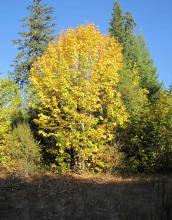
Image Credit: Willamette National Forest
Family: Aceraceae
Common name: bigleaf maple
General bloom time: March - June
Identification: Large deciduous trees that often have multiple stems. Bark is greenish to brown and ridged. Branches are often covered with moss.
Leaves: opposite, simple, heart-shaped and up to 30 cm across. Leaves are often darker green above than below, and have five lobes, which are serrated. In fall the leaves change to yellow and reds.
Flowers: Flowers are in clusters on short stalks that hang down. Flowers are greenish white, and typically 10 - 15 mm across.
Fruit: Seeds are in pairs with wings, forming "helicopters." They are a golden brown color and covered with stiff hairs.
Habitat: Dry to somewhat moist sites. Bigleaf maple often occurs with Douglas-fir trees, and can do well on disturbed sites.
Ecology: Seeds, buds, and flowers of bigleaf maple provide food for numerous birds and small mammals including mice, woodrats, squirrels, chipmunks, finches, and grosbeaks. Squirrels and chipmunks eat the seeds, frequently caching them after removing the hull and wing. Seeds which hang on the tree during fall and winter provide food for finches, grosbeaks, and the Douglas squirrel. Seeds on the ground and young seedlings are eaten by rodents. Rodents eat the roots or pull entire seedlings into burrows. Numerous birds use leaves and seed stalks for nest building.Western tent caterpillars eat the leaves.

Image Credit: Peter Stevens
Fun Facts:
- Bigleaf maple carries more mosses and other plants than any other tree in the region!
- The bark and leaves are used in a number of medicines
Places to find in Portland: Forest Park, Himes Park, Powell Butte, Lewis and Clark State Park, Kelly Point Park, Tryon Creek State Park
References:
Pojar, J. & A. MacKinnon. 1994. Plants of the Pacific Northwest Coast: Washington, Oregon, British Columbia & Alaska. Vancouver B.C., Lone Pine Publishing.
2006. Rubus ursinus. Burke Museum of Natural History and Culture. University of Washington. http://biology.burke.washington.edu/herbarium/imagecollection.php(link is external)
Oregon State University. 2010. Oregon Flora Project Atlas.